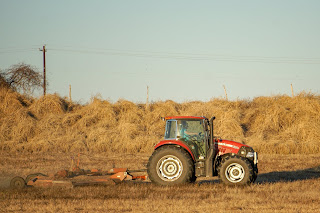Thoughts on the Journey together into God's future. Ecclesiastes 4:9-12 "Two are better than one, because they have a good return for their work: If one falls down, his friend can help him up. But pity the man who falls and has no one to help him up! Also, if two lie down together, they will keep warm. But how can one keep warm alone? Though one may be overpowered, two can defend themselves. A cord of three strands is not quickly broken."
Tuesday, January 01, 2019
Tractor Work
One of my favorite Eugene Peterson stories is the one where the Norwegian farmer/neighbor, Leonard Storm, invites 5-year old Eugene, to ride with him on his big John Deere and plow the field. Great story.
Today Herb suggested that he teach me to drive his International Harvester Farmall tractor so that we could continue planting while he had to be out this afternoon. So Melinda and I spent the afternoon driving the tractor through the field planting the native grass seeds.
Planting the Prairie
The rains finally began to slack up in mid-December and on New Year's Eve and New Year's Day the seed that we'd hoped to have had in the ground in September found its way to the fields. Last week we shredded the standing grass in the field.
Yesterday Texas Parks and Wildlife delivered the no-till seed drill and Herb, our farmer friend and tractor operator, went to work. The no-till seed drill allows the seeds to be planted at the proper rate and depth without disturbing the seed bed in the soil, as disking or tilling would do. This will prevent the weed seeds lying dormant in the ground from germinating along with the seeds we are planting.


Each of the twenty bags held millions of tiny seeds bearing the DNA of grasses, forbs, and flowers that have evolved over eons, adapting to the soil and climate of Texas, contributing to the ecology of the tall grass prairies that covered much of Texas not that long ago. These prairies have shrunk to less than 1% of the original twenty-million acres. In less than a century agriculture and development practically eliminated a beautiful and important feature of creation in North America that had stood in its ground for millennia.
I have two books to recommend to anyone who is interested in prairies and their preservation. Cindy Crosby's The Tallgrass Prairie: An Introduction might become required reading for visitors to our place, just so they'll know the difference between a prairie and an unmowed field. Crosby not only explains prairies and their restoration, but also teaches us how to experience the prairie with all five senses. She also writes a weekly blog called Tuesdays in the Tallgrass, that contains both beautiful photography and thoughtful writing about prairies.
Melinda and I have also enjoyed reading Matt White's Prairie Time: A Blackland Portrait, which deals with the stories of life on the Blackland Prairie of Texas as well as stories of the demise of that landscape. He takes us on visits to various prairie remnants in Texas. Our land is not in the Blackland region, but right where the Blackland Prairie, the Oak Woods & Prairies, and the South Texas Brush Country ecological regions come together. Much of the flora on the Blackland Prairie once grew in this area as well.
Having longed for the rain to cease so that we could plant, we are now eager for moderate winter rains to do their part in helping these seeds fulfill their purpose and bear fruit thirty, sixty, and a hundred-fold.
 |
| Shredding the Fields |
Yesterday Texas Parks and Wildlife delivered the no-till seed drill and Herb, our farmer friend and tractor operator, went to work. The no-till seed drill allows the seeds to be planted at the proper rate and depth without disturbing the seed bed in the soil, as disking or tilling would do. This will prevent the weed seeds lying dormant in the ground from germinating along with the seeds we are planting.
 |
| No Till Seed Drill |


Each of the twenty bags held millions of tiny seeds bearing the DNA of grasses, forbs, and flowers that have evolved over eons, adapting to the soil and climate of Texas, contributing to the ecology of the tall grass prairies that covered much of Texas not that long ago. These prairies have shrunk to less than 1% of the original twenty-million acres. In less than a century agriculture and development practically eliminated a beautiful and important feature of creation in North America that had stood in its ground for millennia.
I have two books to recommend to anyone who is interested in prairies and their preservation. Cindy Crosby's The Tallgrass Prairie: An Introduction might become required reading for visitors to our place, just so they'll know the difference between a prairie and an unmowed field. Crosby not only explains prairies and their restoration, but also teaches us how to experience the prairie with all five senses. She also writes a weekly blog called Tuesdays in the Tallgrass, that contains both beautiful photography and thoughtful writing about prairies.
Melinda and I have also enjoyed reading Matt White's Prairie Time: A Blackland Portrait, which deals with the stories of life on the Blackland Prairie of Texas as well as stories of the demise of that landscape. He takes us on visits to various prairie remnants in Texas. Our land is not in the Blackland region, but right where the Blackland Prairie, the Oak Woods & Prairies, and the South Texas Brush Country ecological regions come together. Much of the flora on the Blackland Prairie once grew in this area as well.
Having longed for the rain to cease so that we could plant, we are now eager for moderate winter rains to do their part in helping these seeds fulfill their purpose and bear fruit thirty, sixty, and a hundred-fold.
Subscribe to:
Posts (Atom)




